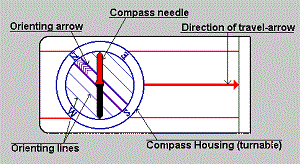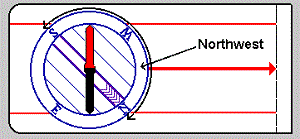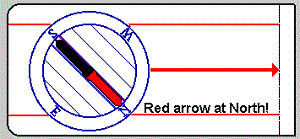Using a Compass
The resources provided here will help you learn how to use a compass effectively and efficiently. You may also be interested in this online guide about how to use a compass correctly.
-
Determining Distance
Determining Distance
Each person has their own comfortable way of walking. When you aren't thinking about how you are walking or trying to hurry, you are probably using your normal pace. A pace is the distance from the heel of one foot to the heel of the same foot the next time it hits the ground. Two steps is one pace.
To establish your natural pace, mark out a distance of 100 feet on flat land and walk along that line, counting each time one foot (the one you started on) hits the ground. Do it several times and average the result.
If it takes Chris an average of 21 paces to cover 100 feet, Chris's pace is about 4 feet 9 inches (4.76 feet). You can calculate this by dividing 100 by the number of paces in 100 feet (100/21 is 4.76). That is four feet and ¾ of a foot. Since a foot is 12 inches, multiple .76 by 12. The answer is just more than nine inches.
Questions
- When pacing out of a dry sinkhole, would you be likely to underestimate or overestimate the distance? Why?
- When pacing through thick palmetto, would you be likely to underestimate or overestimate the distance? Why?
- Sam is six feet tall, and wears a size 15 shoe. Juanita is four feet tall and wears a size six shoe. Is Sam likely to count more or fewer paces than Juanita when they pace out 100 feet?
-
Determining A Bearing
Determining A Bearing
A compass has the following components:
- A magnetic compass needle with one end painted red. It always points to the Earth's magnetic north pole
- A movable housing with marks that indicate 360 degrees
- An orienting arrow that is painted on the bottom of the housing that always points to the N marked on the housing
- A direction of travel arrow on the base plate of the compass
The way the lines are drawn indicate the shape of the land. Ridges and valleys, peaks and flat land, saddles (the low part between two hills), and depressions (noted by hatch marks inside a contour line) can be interpreted from the lines on a map.
The red and black arrow is called the compass needle. On some compasses, it might be red and white, but the red part of it is always pointing toward the Earth's magnetic north pole.
Finding Your Bearing

To determine a bearing (or compass reading), face the direction you wish to travel. Hold the compass level on your open palm - at waist height or higher. The direction of travel arrow should point to your fingertips and the destination.
There is a turnable circle on your compass called the compass housing. On the edge of the compass housing, you will probably have a scale from 0 to 360. Those are the degrees - also known as the bearing or the azimuth.
You should also have the letters N, S, W and E for North, South, West, and East. Twist the compass housing without moving the base plate, so the magnetic needle lies over the north arrow and points to the letter N on the housing. Read the compass bearing off the housing at the direction of travel arrow. You are facing that bearing.
-
Following Directions
Following Directions
What if you want to go in a particular direction? Let's use 300 degrees as an example:
First, find out where on the compass housing 300 degrees is. Then, turn the compass housing so that 300 degrees on the housing comes exactly there where the large direction of travel-arrow meets the housing.

Hold the compass in your hand, keeping it flat, so that the compass needle can turn. Turn yourself, your hand, and the entire compass - making sure the compass housing doesn't turn. Then, turn until the compass needle is aligned with the N inside the lines of the compass housing. You are facing 300 degrees.
Sight across the direction of travel arrow and pick out an object that is exactly in line with the direction of travel arrow. Start walking toward that object.

It is important that the red, north part of the compass needle points to N on the compass housing. If you forget, and line up the other end of the needle, you will be going in the exact opposite direction of where you want! Always take a second look to make sure your calculations are correct.
When you are sure you've got it right, walk off in the direction that the travel arrow is pointing. To avoid getting off the course, make sure to look at the compass frequently. Don't, however, stare down on the compass. Once you have the direction, aim on some point in the distance, and head there.

